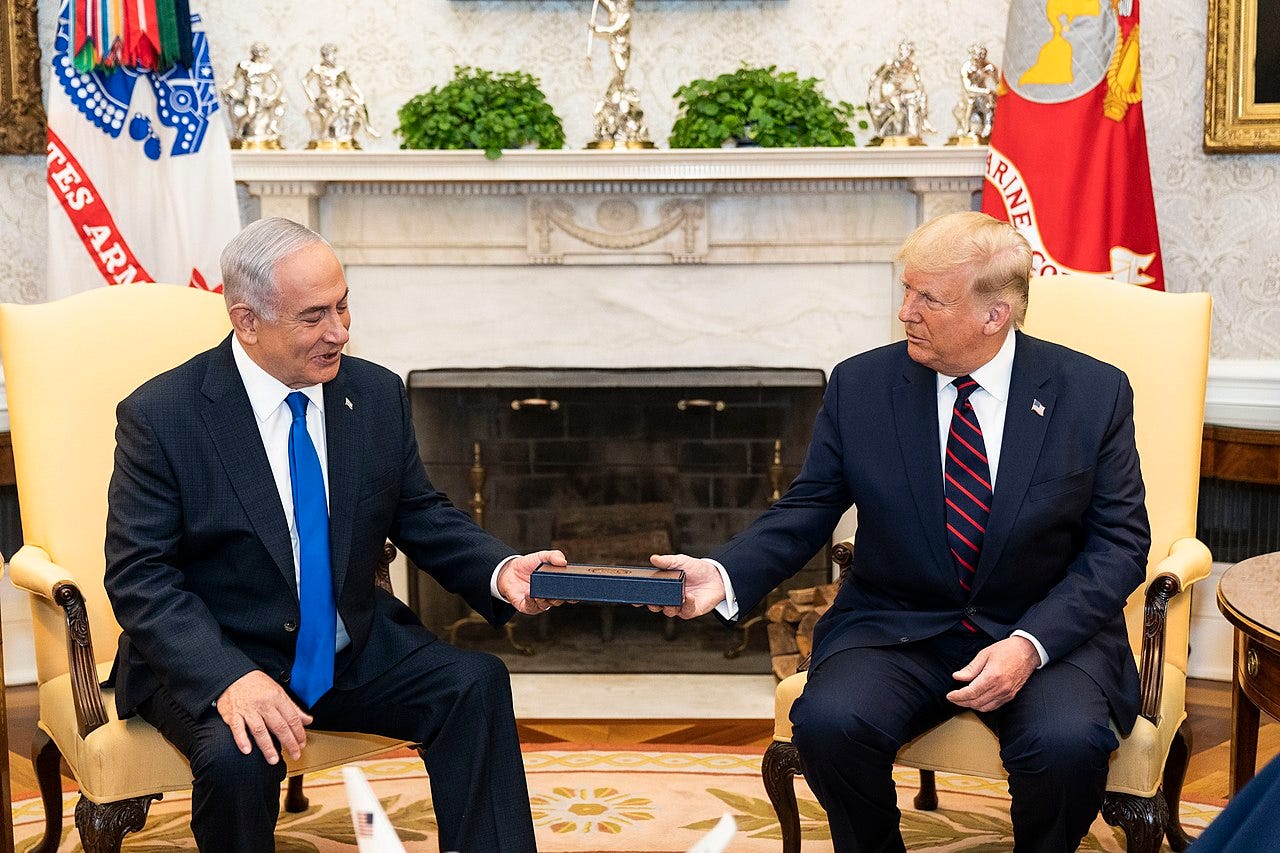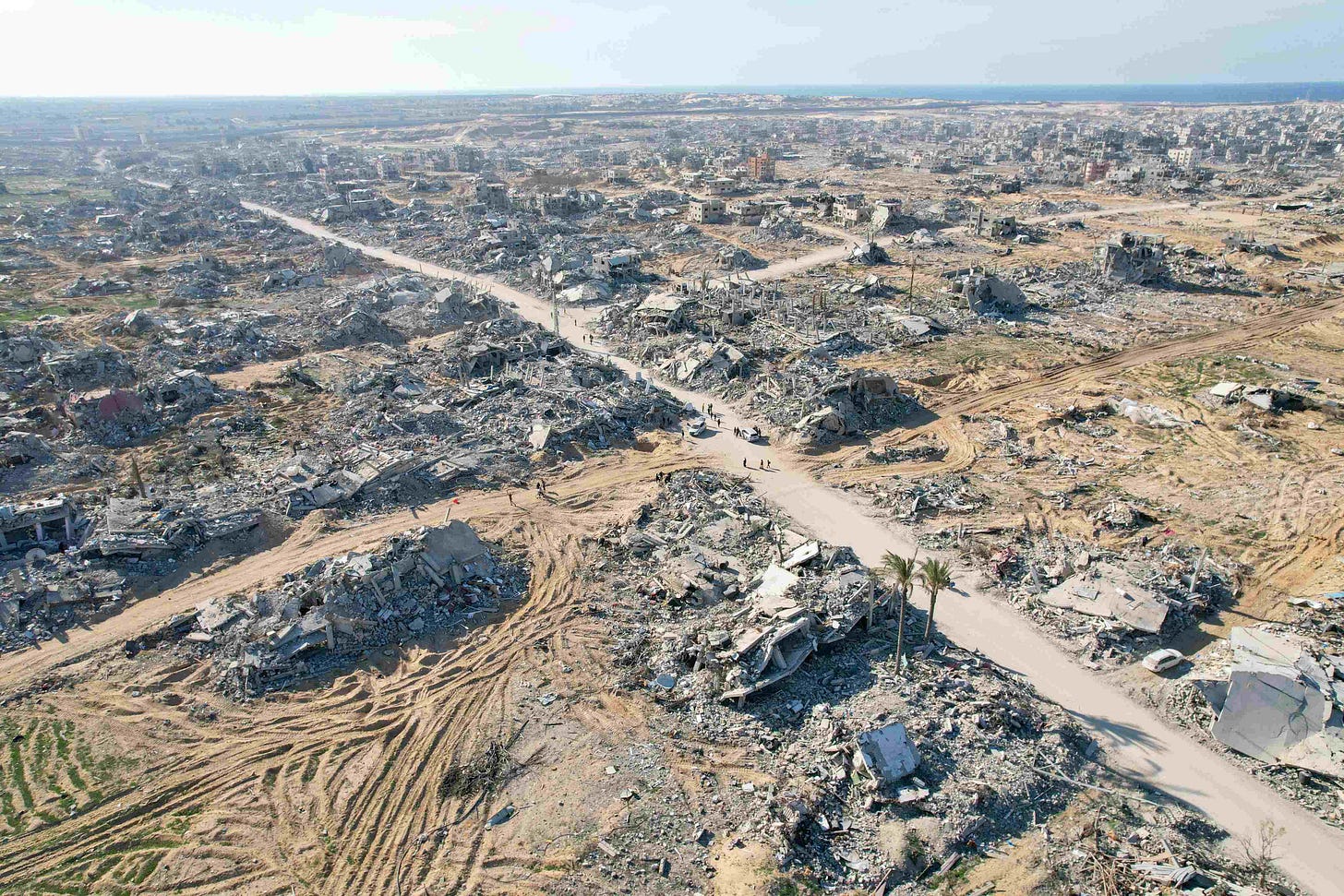“ALL STATIONS, COMMANDER SPEAKING.” It was the night of February 9th, 2025 and an Israeli officer stood flashlit in the gloom of a manmade wasteland. He addressed his troops, unseen in the dark, by radio. “We’re preparing right now to evacuate,” he instructed, then sprinkled his orders with a pinch of optimistic bloodlust. “We’ll be back here, don’t worry…We will return, bring back all the hostages. God willing, the Trump plan will come into effect and we will return to live in all the settlements here.”
That evening, the Israeli army withdrew from the Netzarim corridor, a miles-wide gouge cut through the middle of Gaza, one of the five fingers clutching the crucial axes of control over the Strip. In 2024 Netzarim was a crucial supply road, buffer zone, and staging area, the site on which ground had been broken for future settlement. In early February the ceasefire was not yet a month old, and it seemed as though the IDF’s retreat from this prized zone was an expression of faith – however shaky – in negotiation. Four days earlier, the American president suggested the Palestinians should be given a “good, fresh, beautiful piece of land,” and that Gaza, instead of a home for its own people, should become a home for “the world people” [sic]. Donald Trump turned to Benjamin Netanyahu (in all senses on his right) and said “I think you’ll make that into an international, unbelievable place…[A] riviera of the Middle East.” But even before that brazen and annihilatory press conference, even before the retreat from Netzarim, the ceasefire was already on its way to collapse. The Israelis killed it. They killed it deliberately, and with malice.
Blowing Up Everything is Beautiful: Israel’s Extermination of Gaza
is now available for pre-order. Get your copy here.
Monday, February 3rd is the crucial moment. On that day the second phase of ceasefire negotiations were due to begin in Doha. The Israeli government had already accepted, in principle, a permanent truce in exchange for Hamas releasing all the living hostages, as well as the remains of dead captives. Except Netanyahu ordered the negotiating team not to leave for Qatar. Whether a stall to see what grotesque promissory notes Trump might issue at the White House the next day or a deliberate provocation, the effect was the first open violation of the ceasefire’s terms. Another five days would pass – Saturday 8th – before Netanyahu allowed the team to leave, though they were given no political brief. Instead, they did the diplomatic equivalent of thumb-twiddling, having talks about talks, with no authority to engage in genuine negotiation.
Meanwhile, at the border crossings into Gaza, the ceasefire was further breached. By its terms, hundreds of thousands of tents and mobiles homes were supposed to enter the blighted Strip, along with lorry-loads of food aid, urgent medical supplies, and heavy machinery for the clearance of rubble. Instead, the Israelis were holding up trucks and turning back drivers at the gates. Fifty fuel tankers were supposed to enter per day, on paper. Just 25 were making it through. If anyone thinks this grievance was false or Hamas propaganda, the stall in aid was verified by the New York Times’ own reporters who stated that according to “three Israeli officials and two mediators…Hamas’s claims were accurate.” Grotesque as their treatment might be, the hostages are Hamas’ only leverage against a monstrous oppressor with a superpower acting as its patron and armourer. Using their survival as a bartering chip is not a break with negotiating in good faith. Thus on Sunday, February 9th, as Netanyahu was returning to Tel Aviv from Washington, Hamas insisted they would delay the next batch of releases until Israel held up its end of the bargain. Two days later, the Israeli newspaper Maariv, citing IDF sources, said Hamas “has not violated the ceasefire agreement.”
If the Israeli government’s violations had so far been covert and procedural, after Monday 10th they would be hostile and shameless. Trump issued his unilateral demand for the release of all hostages by midday on the 16th or “hell would break loose.” At a cabinet meeting earlier in the day, Netanyahu insisted Hamas should not be allowed to rule the Strip – another provocation given the postwar (dare we say post-occupation?) governance of Gaza was not set to be discussed until the third phase. (For its part, Hamas has already declared its own self-abnegation). Seizing the opening Trump had made to break totally with the established guidelines of the ceasefire, Netanyahu later that afternoon put out his own ultimatum: the hostages should be released by Saturday noon, though his nebulous language didn’t specify whether that meant all remaining hostages, or just those which Hamas had postponed. Confusion, too, is a negotiating tactic, and in this instance, it was a demand impossible to fulfil.
The Israelis killed the ceasefire. They killed it deliberately, and with malice.
On Wednesday, February 12th the IDF killed two people in Rafah, supposedly because they were flying a drone. Far from the first deaths at the army’s hands during this period of alleged truce, it was the most flagrant. (Rough numbers suggest as many as 155 Gazans were killed between January 19th and March 18th). It was also a test case. How openly could the army violate the ceasefire’s terms before Hamas were incited into a response? Perhaps Netanyahu and the IDF’s commanders underestimated Hamas’ naiveté and good faith, their willingness to abide by the original agreement. No armed response came. The army redeployed tanks and troops to the border areas all the same.
The IDF was supposed to withdraw from the Philadelphi corridor, on the border with Egypt, no later than fifty days after the ceasefire came into force: March 10th. It did not. The regime in charge of Israel’s inland empire in the West Bank and Gaza, the Coordinator of Government Activities in the Territories (COGAT), strictly curtailed the number of volunteer medical and aid workers allowed to enter the Strip. On March 2nd, even the tiny dribble of supply allowed in was cut off again. A state of total siege was imposed once more. The miniscule flow of power into Gaza was throttled, threatening the last desalination plant left functioning. The vicegrip tightened.
On March 18th, 400 Gazans were slaughtered in airstrikes and shelling. The nightmare begins afresh, and the ceasefire that had been eroded by Israel since early February lies buried with the slain. One day later Defense Minister Israel Katz addressed the civilian population of Gaza directly, and further wrecked the distinction between civilian and combatant – a distinction long abused in fifteen months of annihilation. “This is your final warning,” Katz said. “You will bear the full cost…Israel will act with force you have not known before.” If Gazans – homeless, starving, blighted with injury and disease – do not magically overthrow Hamas, “the alternative is destruction and total devastation.” Another demand impossible to fulfil, but one that betrays the real purpose all the same. For fifteen months the Israeli government told you what it was doing while they did it. Now it is no different. Annihilation is the method and the goal.






